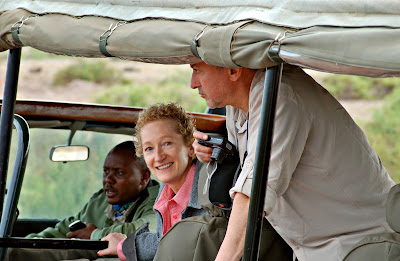Day 3
I woke up at around 4:00AM. A fantastic lighting storm was developing in the direction of Mount Kili, in the thick of black-gray clouds surrounding its peaks. Lighting veins of incredible colors reaching into each and every direction (some were bright enough to illuminate the smaller Kili peak). Right then, for the first time in my life I saw a radial lighting - a burst of lighting resembling that of a bursting firework. About five minutes later a wave of cool, moist breeze moved through our tent.
 |
| Another beautiful morning in Amboseli. Looking towards the Tanzanian border. |
 |
| About ten minutes later we are welcomed by a small family of elephants (and a few-months-old baby elephant). |
 |
| Our kids in close proximity to the same Elephant family. Our guides are expert interpreters of Elephant body language and assured us it was totally safe (as long as you are not a threat to them). |
 | ||||
| A lucky photo. |
 |
| Same Elephant family in aptly named elephant grass (the dried grass is used as thatch and even as bedding) |
 |
| Always on the move |
 |
| One of the most aggressive animals of the Safari |
 |
| An interesting amalgamation of Safari wildlife. |
 |
| A lone cape buffalo and his faithful bird companion |
 |
| Always walking single file |
 |
| Constant reminders of life and death of Safari |
 |
| Past the entry into Baboon conservancy (near Amboseli) we are greeted by this... |
 |
| Baboon habitat in the same conservancy |
 |
| Outside the conservancy our guide spots a trio of relatively fast moving Elephants. |
 |
| Approaching another small family of elephants in late afteroon |
























































